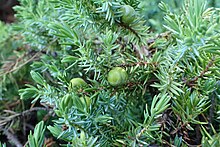Juniperus lutchuensis
| Juniperus lutchuensis | |
|---|---|

| |
| Scientific classification | |
| Kingdom: | Plantae |
| Clade: | Tracheophytes |
| Clade: | Gymnospermae |
| Division: | Pinophyta |
| Class: | Pinopsida |
| Order: | Cupressales
|
| Family: | Cupressaceae |
| Genus: | Juniperus |
| Section: | Juniperus sect. Juniperus
|
| Species: | J. lutchuensis
|
| Binomial name | |
| Juniperus lutchuensis Koidz.[1] | |
| Synonyms | |
Juniperus lutchuensis or Ryūkyū juniper (オキナワハイネズ, Okinawa-hainezu) (syn. Juniperus taxifolia var. lutchuensis (Koidz.) Satake) is a species of juniper native to the Ryūkyū Islands, Izu Islands, Izu Peninsula, and Bōsō Peninsula, Japan.[3][4][5]
Taxonomy
Juniperus lutchuensis was first
Description
Juniperus lutchuensis is an
The seed cones are berry-like, green ripening in 18 months to purple-brown; they are spherical, 8–9 mm diameter, and have three or six fused scales in one or two whorls of three; the three larger scales each bear a single seed. The seeds are dispersed when birds eat the cones, digesting the fleshy scales and passing the hard seeds in their droppings. The pollen cones are yellow, 5 mm long.[3]
Distribution and habitat
Endemic to Japan, it may be found growing in coastal areas, on cliffs and in sunny spots, on the Izu Peninsula and Bōsō Peninsula of Honshū, the Izu Islands, Tanegashima (Ōsumi Islands), Tokara Islands, Amami Ōshima and Tokunoshima (Amami Islands), and, within Okinawa Prefecture, on Okinawa Island and Yagaji Island, Iheya Island, Izena Island, and Aka Island, Tokashiki Island, and Zamami Island (Kerama Islands).[5]
Conservation
Much of its habitat has been lost due to coastal development and revetments, and it has also often been taken from the wild for use in gardens and bonsai.[5] Its conservation status is uncertain, but it is rare and may become threatened.[3] In the 2018 Okinawa Red Data Book, Juniperus taxifolia var. lutchuensis is assessed as Endangered.[5]
References
- ^ ISSN 0006-808X.
- ^ a b Satake Yoshisuke [in Japanese] (1962). オキナワハイネズに関する問題 [Problems Relating to the Ryukyu Juniper]. Bulletin of the National Science Museum. 6 (2). National Science Museum: 187–247.
- ^ ISBN 1-4120-4250-X
- ISBN 978-4-486-01897-1.
- ^ a b c d e Okinawa Prefecture, ed. (5 December 2018). レッドデータおきなわ 維管束植物 [Red Data Okinawa: Vascular Plants] (PDF) (3 ed.). Okinawa Prefecture. p. 141. Retrieved 30 May 2022.
- ISBN 1-84246-068-4
